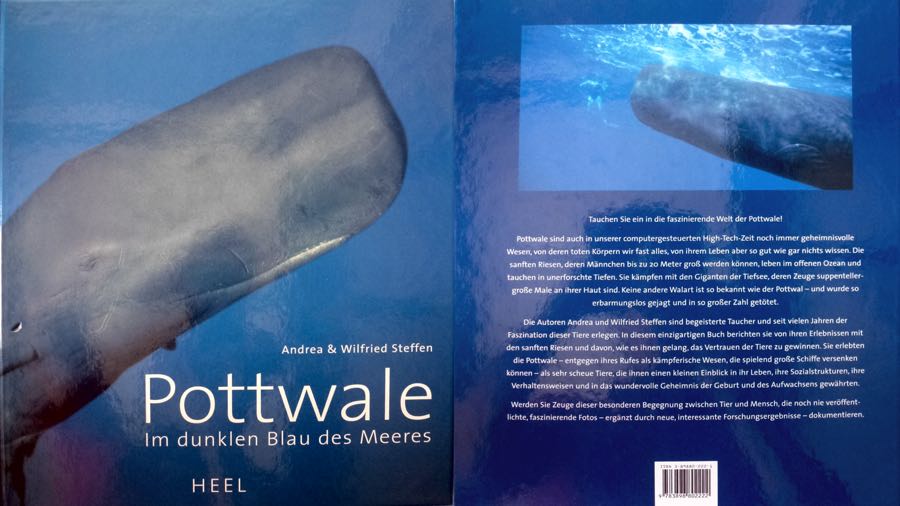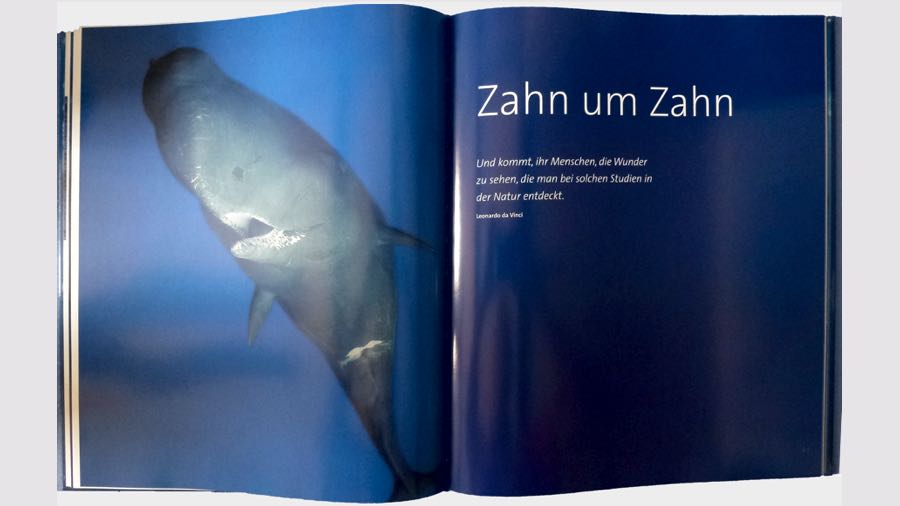
Sperm whales – in the dark blue of the sea
Excerpt from our chapter: Tooth for tooth
Ingestion
It is not yet clear when the baby sperm whales begin to eat solid food. Researchers assume that at least the teeth in the lower jaw must have visibly grown out in order to be able to hold the prey.
During one of our daily trips we met a very friendly and well-known young sperm whale that we had already met 1 ½ years ago. However, at 4 to 6 months old, he was much younger and smaller and only measured 4 to 5 meters. It had now reached an impressive size of around 7 to 8 meters. We visited him underwater and in his playful spirit he was even nice enough to show us his open mouth in full size. After we were convinced that he really just wanted to play, we took a look inside. His teeth hadn't erupted yet. You could already see them, but they were still covered with skin. They looked like little bumps. We could also clearly see the notches in his upper jaw, which serve as a counterpart to the lower jaw teeth and can therefore accommodate them when the mouth is closed. This is made possible by the fact that the teeth in the upper jaw rarely grow out.
At the age of 20 - 22 months, the young whale does not yet have any teeth and is probably still nursing.
Once his teeth have grown out, he doesn't need them to chew his prey, but instead swallows it whole in one piece. The sperm whale only uses its teeth to hold onto its prey until it has pushed it down its throat with its tongue.
Ancestors
The teeth of mammals all developed according to the same pattern, which could even be proven on the teeth of mammalian ancestors. The development of teeth can be traced back to a common older archetype. It is a single-celled, cone-shaped reptilian tooth that is roughly comparable to the teeth of today's toothed whales.
Günter Behrmann researched this intensively and reported to us in detail about the findings of his years of research on whale teeth.
Numbers
Even today, toothed whales still have more tooth germs than are needed. The number of teeth depends on the space in the jaw.
The East Pacific dolphin represents an extreme. There are up to 252 small, sharp teeth on its long jaw. These are more than any other mammal. The other extreme is found in the northern duck whale, which has no teeth at all in its upper jaw and only two to four teeth in its lower jaw.
Because the jaws of all toothed whales are not the same length, the number of teeth varies within a species. It is therefore difficult to determine a species based on the number of teeth.
Growth
It is often said that you can tell the age of a whale by looking at the growth rings on the ivory. Each growth ring can supposedly be counted for a year of life. However, this type of age determination is far too imprecise because the growth rings are heavily influenced by the food supply.
What makes matters worse is that the teeth are coated in ivory even before they begin to grow out, meaning that the first rings of growth appear before the teeth erupt. Since no one can say how many growth rings were created during this time, all age determinations remain hypothetical. In order to be able to recognize these growth rings, a complex preparation and chemical process is necessary, which Kurt Weidemann from the Löbbecke Museum described to us as follows:
“First, the sperm whale's tooth was cut lengthwise with a rock saw. What was striking was how tough the mixture of minerals and framework whites, i.e. inorganic and organic materials, was. The cut surface was then sanded first on the belt sander, then wet with the abrasive grain machine. The polishing then took place. The tooth, which had been treated mechanically, now had to be demineralized in an immersion bath made of 10% formic acid for 30 hours and then watered for the same amount of time.
When the drying process was completed, the growth rings clearly rose up.”
Construction

The structure of the teeth is the same in all mammals.
The mammalian teeth consist of a tooth germ, inside which lies the tooth cavity and in which the vessels for tooth supply and the tooth nerves end.
The tooth germ is surrounded by dentin. This in turn is covered with a very hard enamel layer. Until this process, the teeth of mammals can even be compared to human teeth.
In sperm and killer whales, the teeth are also covered by periodically growing ivory. This ivory is similar to the structure of a bone and consists largely of calcium and phosphate. But it also contains minerals.
The ivory from sperm whale teeth was a sought-after product during whaling times. Many whalers decorated the sperm whale teeth with carvings that mainly showed motifs from whaling and sold them to tourists for a lot of money.
Can we compare whale teeth to human teeth? We certainly find similarities in the structure of their teeth, but can whales also have milk teeth? We humans still have baby teeth, which we lose from the age of 6. The teeth that then grow develop into permanent teeth.
Other mammals also develop two sets of teeth. In contrast to humans, it is the milk teeth that form the permanent set of teeth, while the second teeth only develop when they are really needed.
In the case of toothed whales as marine mammals, the formation of teeth behaves differently. It was previously known that toothed whales only form a single set of teeth from their first teeth (milk teeth) and no further teeth develop.
However, when examining young porpoises, Günther Behrmann was able to demonstrate the potential for a second set of teeth. However, these approaches were no longer found in adult porpoises. So they have regressed over time. Toothed whales only grow teeth once.
The sperm whale is once again a major exception here.
Caries
Another amazing piece of news emerged. Behrmann even found some of the teeth examined with caries.
He discovered new teeth under the carious remains that were already ready to take over the function of the main teeth. In total, this marine mammal had 200 replacement teeth in its mouth, which, according to Behrmann, was an absolute revolution and has not yet been described in any literature.
Equally astonishing is the fact that sperm whales can suffer from tooth decay.
In humans, tooth decay is caused by sugar-eating bacteria that produce organic acids. These acids slowly dissolve the hard tooth structure. Time plays a big role here. If the bacteria in plaque can stick to the tooth long enough and are supplied with sugar (which is present in most foods and drinks), a hole is created.
However, the sperm whales only consume very little sugar and their teeth are additionally protected by a thick layer of ivory. This makes them appear to be invulnerable. The salt water and natural abrasion also clean the whale's teeth and thus prevent tooth damage. This makes the large cone-shaped sperm whale teeth look very healthy.
But appearances are deceptive, because the jaw skin is very vulnerable and microorganisms can penetrate from there. They attack the tooth root and slowly destroy it. However, the sperm whale has developed natural defenses for this. After the carious tissue has been broken down, it fills the resulting holes with healthy tissue. The repair of the tooth begins. First, the points and edges caused by bone erosion are defused, at the same time small ivory segments are created on the healthy tissue, which are put together like a sieve-like ivory roof and thus close the hole. After abrasion and seawater have polished the tooth again, the traces of carious destruction can no longer be seen with the naked eye. The discovery was therefore only possible after detailed investigations.





 Die Autoren Andrea und Wilfried Steffen sind begeisterte Taucher und seit vielen Jahren der Faszination dieser Tiere erlegen. In diesem einzigartigen Buch berichten sie von Ihren Erlebnissen mit den sanften Riesen und davon, wie es ihnen gelang, das Vertrauen der Tiere zu gewinnen. Sie erlebten die Pottwale – entgegen ihres Rufes als kämpferische Wesen, die spielend große Schiffe versenken können- als scheue Tiere, die ihnen einen kleinen Einblick in ihr Leben, ihre Sozialstrukturen, ihre Verhaltensweisen und in das wundervolle Geheimnis der Geburt und des Aufwachsen gewährten.
Die Autoren Andrea und Wilfried Steffen sind begeisterte Taucher und seit vielen Jahren der Faszination dieser Tiere erlegen. In diesem einzigartigen Buch berichten sie von Ihren Erlebnissen mit den sanften Riesen und davon, wie es ihnen gelang, das Vertrauen der Tiere zu gewinnen. Sie erlebten die Pottwale – entgegen ihres Rufes als kämpferische Wesen, die spielend große Schiffe versenken können- als scheue Tiere, die ihnen einen kleinen Einblick in ihr Leben, ihre Sozialstrukturen, ihre Verhaltensweisen und in das wundervolle Geheimnis der Geburt und des Aufwachsen gewährten.
 Werden Sie Zeuge dieser besonderen Begegnung zwischen Tier und Mensch, dokumentiert mit noch nie veröffentlichten, faszinierenden Fotos und ergänzt durch neue, interessante Forschungsergebnisse.
Werden Sie Zeuge dieser besonderen Begegnung zwischen Tier und Mensch, dokumentiert mit noch nie veröffentlichten, faszinierenden Fotos und ergänzt durch neue, interessante Forschungsergebnisse.
 Spannend und einfühlsam lassen sie die Leser an ihren hautnahen Walbegegnungen teilnehmen. Mit einmaligen Aufnahmen, vor allem von den drei Großen: den Blau-, Buckel- und Pottwalen, belegen sie ihre in weltweiten Beobachtungen gesammelten Erkenntnisse. Einzigartig ihre jahrelange Begleitung der „Group of Seven“, einer Gruppe von Pottwalen, den größten Raubtieren der Erde, bei der sie das Heranreifen eines Jungbullen von der Geburt an erleben konnten.
Spannend und einfühlsam lassen sie die Leser an ihren hautnahen Walbegegnungen teilnehmen. Mit einmaligen Aufnahmen, vor allem von den drei Großen: den Blau-, Buckel- und Pottwalen, belegen sie ihre in weltweiten Beobachtungen gesammelten Erkenntnisse. Einzigartig ihre jahrelange Begleitung der „Group of Seven“, einer Gruppe von Pottwalen, den größten Raubtieren der Erde, bei der sie das Heranreifen eines Jungbullen von der Geburt an erleben konnten.
 Tauchen Sie ein in die Welt der Wale. Erleben sie Großaufnahmen aus allernächster Nähe und erfahren sie interessante Forschungsergebnisse aus dem geheimnisvollen Leben dieser Meeresriesen.
Tauchen Sie ein in die Welt der Wale. Erleben sie Großaufnahmen aus allernächster Nähe und erfahren sie interessante Forschungsergebnisse aus dem geheimnisvollen Leben dieser Meeresriesen.